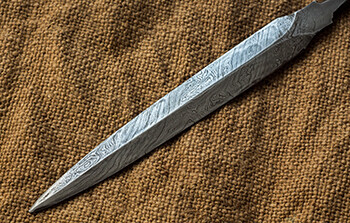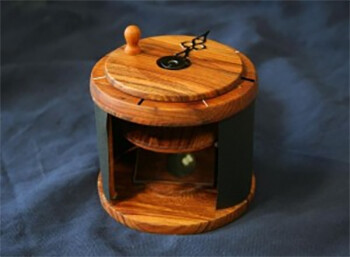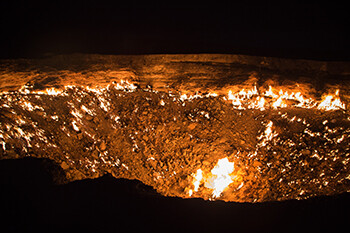Mwalimu-G
Elder Lister
6 Ancient Bizarre Beliefs With Logical Explanations

Our ancestors were pretty dumb, right? Walking around thinking photographs would steal your soul and that cigarettes counted as a health food. Honestly, it's a miracle they lived long enough to continue the bloodline that would lead to you reading this intro paragraph on the toilet right now. (Yes, we know. We always know.)
But, sometimes, they blindly stumbled off their path of madness and onto the right trail ...
6
Witches Brews Were Actually Effective Medicines (And at the Very Least, Got You High)
Witches fly on brooms, cackle in the night, and make terrible remakes starring Anne Hathaway; that's what the old myths tell us. But it's worth delving into who these old witches actually were and what they were doing trying to commune with the Devil. Turns out they were practicing medicine.
Thing is, in the Middle Ages, 'real' doctors sucked. They were as likely to babble on about the four humors as they were to give you a hole in the head. Even with their heads full of nonsense, they were hard to train, which made them both rare and expensive. That's why most peasants relied on the folk remedies passed down by women, which wouldn't give you lead or mercury poisoning and had the added benefit of actually helping cure you. While this gave women a lot of power, doctors and the Church didn't much like this. It helped lead to the whole 'heads I kill you, tails you die' witch trials, where you could be killed just as easily for sexing the Devil as you could be for practicing medicine without a license.
At the time, people didn't know why these remedies worked, but when modern doctors researched them, they found they were, in fact, effective medicines. One scientist, William Withering, didn't have any medicine to cure a patient with heart trouble, so the patient went down to his local healer (read: witch), who offered him a folk remedy that worked. Because people had *mostly* stopped burning witches in 1775, Withering was able to track the healer down; she revealed the brew's active ingredient was foxglove, which is now the modern basis for heart failure drug digoxin.

Atiger/Shutterstock
Albeit disappointing that it doesn't look like tiny, adorable animal gloves, as the name implies.
A whole class of witches brews, called flying ointments, got you high. Witches would call the high "being on a journey," which someone interpreted as flying on brooms, and others interpreted as being, like, totally out there, you guys. Compounds like the Nightshade alkaloids hyoscine (a common treatment for motion sickness) and atropine (nerve gas antidote and muscle relaxant) were all part of these brews.
Even weirder, it's theorized that the Weird Sisters from Macbeth weren't just spouting nonsense; they were actually babbling about real medical herbs that witches used to help heal people.
Related:
5 Bizarre Ways People Got F'ed Up Throughout History
5
Garlic and Holy Water Would Actually Protect You From Monsters
Say hundreds of years ago, you were a writer coming up with a list of things that fight vampires, aside from a time-traveling Wesley Snipes. What would you come up with? A cross would make sense, because Christianity, but why holy water? And hell, garlic? Garlic's not exactly a spiritual powerhouse. And sunlight? Do you think the predator of the most dangerous game is going to be taken down by a little sun?
Well, it turns out that the symptoms of vampirism are very, very close to symptoms of the disease furious rabies (which we're sure will star Vin Diesel some decades in the future). It's a neurological disease that attacks the brain and is incurable unless you have a very unpleasant set of shots to the belly if you get bit by an infected animal.
Without those shots, its symptoms include a laundry list of vampire characteristics: an aversion to strong stimuli, including bright light and strong smells (read: garlic); hydrophobia, so you'd be thirsty as all get-out but unable to overcome your fear of water (read: holy water); and a fear of breezes and mirrors (read: Edward Cullen).

Vera Petruk/Shutterstock
Also, they'd fear a wooden stake to the heart because it's a wooden stake to the heart.
Even weirder, the disease makes it really hard to swallow, so the victim starts foaming at the mouth and hissing, because again, why would a vampire hiss? We want vampires to be scary, and we call it a hissy-fit for a reason. Of course, furious rabies' biggest kicker is that the victim quickly gets crazy aggressive and wants to bite everything that moves, basically acting like any rabid animal would.
European vampire hysteria often coincided with massive outbreaks of furious rabies, like the one in Hungary in the 1730s. And the European animals that spread rabies -- wolves, dogs, bats -- are all associated with vampirism. Combine that with the fact that fingernails and teeth appear to grow after death (thanks to dehydration), and decomposing entrails take on a dark red color that looks like horror-movie blood (thanks to the ever-presence of death that we can only distract through dick-jokes), and you've got the makings of an excellent, scary myth.
Related:
5 Downsides To Being A Movie Monster Nobody Brings Up
4
'Spirit Infused' Viking Steel Was Actually Stronger
Vikings were world-conquering badasses, as Cracked has covered at length before. Able to raid empires from Russia to England, they inspired more heavy metal albums than horror, boobs, and chrome combined.

Epic Records
We don't know if Vikings would listen to Molly Hatchet, but they'd at least have to be flattered.
What's weird is that they had to do all this badass world-beating while only having access to poor quality iron. They called it bog iron, and although bog chemistry concentrated iron for extraction, it made for really terrible sword making. This meant that weapons wouldn't stay sharp, would break if stressed, and leave gross bog crumbs all over the table.
What the Vikings needed was all-business crucible steel, the kind you find in all the swords of legend and weirdly specific dating profiles. It was made by heating wrought iron to absurd temperatures with materials rich in carbon. This gave the metal a high carbon content, making it stronger and better able to maintain an edge.
The process for making it was originally discovered in India. But because Europeans didn't know where India was and were able to trade for Indian swords in Damascus, Syria, they called the metal in the blades Damascus Steel.

Alexandra Lipnitskaya/Shutterstock
Which had the dual advantage of added strength and looking rad AF.
It was originally thought that Vikings got their steel through this trade. But there's a much more badass (one might say metal) explanation: Instead of trading, Vikings were able to turn their piss-poor iron into crucible steel swords through a ritual that infused their steel with the burnt bones of dead animals and ancestors. We know the practice was widespread because animal and human bone fragments remain common discoveries in old abandoned Viking forges. They did this thinking they were transferring the spirit of the bone's owners to their swords, but what they were doing was adding carbon to the iron, creating a form of crucible steel.
This meant that they had some of the best weaponry in Europe at the time and a kind of steel that Europe wouldn't see again until the Industrial Revolution. It's why the best Viking swords, called Ulfberth swords, were extremely strong, found all throughout the lands the Vikings conquered and were popular enough to inspire their own fakes market.
Related:
A Stealthy Viking Is So Crazy That It Just Might Make 'Assassin's Creed' Awesome Again
3
Egyptian Eyeliner Protected Your Eyes
In this wonderland of bb guns, drugs, and random poop-flinging monkeys, our eyes are fragile things. Nowadays, you have the possibility of turning into a bitchin' cyborg with digital vision; that wasn't true of our ancient ancestors. Back then, it was fairly easy to get the ultimate case of pink-eye that would leave you blind forever.
Ancient Egyptians actually had a way of dealing with this. They created an eyeliner that they thought blessed with the healing powers of the god Horus, the falcon god created from a phallus tossed into the ocean and Bill Maher's favorite Christ-themed superhero. Anyone who's watched a football game knows that black eyeliner protects the eye from glare, but nobody thinks of their mascara as having magic powers.
When an analytical chemist got ahold of some ancient Egyptian eyeliner (and probably a curse of some kind), they found something interesting: two types of lead salts that weren't naturally occurring. This meant that the Egyptians actually had to synthesize the salts, which isn't easy under the best of circumstances, and certainly not under ancient world conditions. Not to mention, lead is about as good for us as reality TV: a little will make you feel gross, and a lot will destroy both your body and mind.

Tan_tan/Shutterstock
... And it doesn't look like a little was the fashion.
Weirdly, these lead salts had protective properties in multiple ways. First, the lead salts had anti-microbial properties, making sure that none of the microbes that swam in the Nile had a chance to swim into Egyptian eyes. Second, because the body knows that lead isn't good for us, the lead near their eyes activated an inflammatory response, which is the body's first level of immune protection, and would help kill infection before it had a chance to take root.
"Hey, wouldn't that just poison the hell out of Egyptians?" Well, yes, dear reader, it would, and it probably did. But because Egyptians didn't live much longer than their 30's, they didn't suffer as much from the bioaccumulation of lead if they would've lived longer.
Plus, they didn't straight up eat the stuff like the Romans did. So that probably helped.
Related:
5 Ridiculous Modern Fashions With Badass Historical Origins
2
Sunstones Weren't Magic, But They Did Help Vikings Navigate the Atlantic
In addition to being incredible fighters, Vikings were also incredible navigators. That was the only way they could hit up Iceland, Greenland, and North America long before a certain Italian backed by the Spanish crown. And they didn't have things like clocks, compasses, or astrolabes that could help a ship determine its location like they had in the Age of Sail.
If you read the old Norse stories, you'll find references to a magic stone that allowed Vikings to navigate their ships across the Atlantic, divining the path of a ship through any sort of stormy seas. These magic stones were called Sunstones, or solarsteinns if you want to be all grimdark about it, and they could supposedly delineate the sun's position even if it was obscured. This kind of magic would've been essential in the North Atlantic, a region famous for its fog and clouds, which probably made for a lot of goth Vikings.
For centuries, people thought this was a myth, but recently, scientists have theorized that crystals (calcite, or Icelandic Spar, not the garbage geodes you can buy at a New Age store) could do exactly what the Norse stories said they could do by refracting sunlight, without any of the magic everyone thought they needed.
When light goes through calcite, it separates into two beams in a process called birefringence. One beam takes a different path off the main beam, causing two images to form when you look through it or aim the light at a surface. However, if you move the calcite into a specific position, the images become equal, and this allows a sailor to determine the position of the light's source even without seeing it. As long as you took a sighting at least every three hours, you were pretty much set to go wherever the hell you wanted. They tested it with lasers in France, computers in Hungary, and built a device that could do it; trust us, it's legit.

Guy Ropars/University of Rennes
Less 'MY AXE IS NAMED ANNIHILATOR!' and more 'I better fiddle with the little rock again.'
To add even more weight to that theory, archeologists actually found a sample of a 'Sunstone' in a wreck off the English coast from 1592, theorizing that the British learned the trick from the Vikings, who made it a point to conquer the hell out of England during the Viking Age.
Related:
5 Advanced Ancient Technologies That Shouldn't Be Possible
1
Fire-breathing Dragons Were Underground Pockets of Gas
We all know that dragons aren't real -- your sad uncle, with the nickname that he tries to keep making happen, doesn't count -- but we can recognize that, if this is the case, fire-breathing dragons are a weird kind of monster. First, if they live primarily underground, why would they have wings and fly? Why would they be hoarding treasure? Why would they think they could fight the combined forces of Matthew McConaughey and Christian Bale at the same time?
Well, it's hypothesized that, back in the Iron Age, people would seal up treasure in the tombs of kings and rich people. The thing is, they would seal these tombs with a ton of things that decomposed: people, animals, vegetables, etc. The buried flesh would emit gasses as they decomposed, and with nowhere to go, they would create pressurized gas pockets. Try to open the tombs with a torch so you could see, or cause a spark with an iron spade, and BOOM!: big, firey oblivion in a world where Michael Bay wouldn't be around for thousands of years.
In Wales, there was a king who was trying to make his walls impenetrable. The only thing is, the walls kept falling down. A young real-life Merlin told the king that it was dragons fighting underground, possibly because he believed it, possibly because when a king asks you a question, you give him an answer even if it's nonsense. Instead of underground lizards, it was more likely gas pockets buried in the vast Welsh coal deposits underground.
That wasn't just true of the old Arthurian legends either. The Chimera, the famous creature with the tail of a snake, the body of a lion, and the head of a stag, also came about in a similar way. There was a mountain in Turkey named Mt. Chimera because ancient people are just as lazy as we are, that constantly leaked methane, which sometimes will shoot flame up from the earth. Mash of bunch of animals people are naturally afraid of together, and boom, you got your monster.

Iwanami Photos/Shutterstock
You try looking at a flaming crater with a 700 BC education and come up with an explanation besidesmonsters.
And honestly, if there's something terrible beneath the earth, waiting and guarding treasure, you can bet nobody's volunteering to check if there were huge monsters ready to murder them. Which is a good, logical policy we moderns routinely ignore.
-CRACKED
- By
 Steven Assarian·
Steven Assarian·- March 03, 2021

Our ancestors were pretty dumb, right? Walking around thinking photographs would steal your soul and that cigarettes counted as a health food. Honestly, it's a miracle they lived long enough to continue the bloodline that would lead to you reading this intro paragraph on the toilet right now. (Yes, we know. We always know.)
But, sometimes, they blindly stumbled off their path of madness and onto the right trail ...
6
Witches Brews Were Actually Effective Medicines (And at the Very Least, Got You High)
Witches fly on brooms, cackle in the night, and make terrible remakes starring Anne Hathaway; that's what the old myths tell us. But it's worth delving into who these old witches actually were and what they were doing trying to commune with the Devil. Turns out they were practicing medicine.
Thing is, in the Middle Ages, 'real' doctors sucked. They were as likely to babble on about the four humors as they were to give you a hole in the head. Even with their heads full of nonsense, they were hard to train, which made them both rare and expensive. That's why most peasants relied on the folk remedies passed down by women, which wouldn't give you lead or mercury poisoning and had the added benefit of actually helping cure you. While this gave women a lot of power, doctors and the Church didn't much like this. It helped lead to the whole 'heads I kill you, tails you die' witch trials, where you could be killed just as easily for sexing the Devil as you could be for practicing medicine without a license.
At the time, people didn't know why these remedies worked, but when modern doctors researched them, they found they were, in fact, effective medicines. One scientist, William Withering, didn't have any medicine to cure a patient with heart trouble, so the patient went down to his local healer (read: witch), who offered him a folk remedy that worked. Because people had *mostly* stopped burning witches in 1775, Withering was able to track the healer down; she revealed the brew's active ingredient was foxglove, which is now the modern basis for heart failure drug digoxin.

Atiger/Shutterstock
Albeit disappointing that it doesn't look like tiny, adorable animal gloves, as the name implies.
A whole class of witches brews, called flying ointments, got you high. Witches would call the high "being on a journey," which someone interpreted as flying on brooms, and others interpreted as being, like, totally out there, you guys. Compounds like the Nightshade alkaloids hyoscine (a common treatment for motion sickness) and atropine (nerve gas antidote and muscle relaxant) were all part of these brews.
Even weirder, it's theorized that the Weird Sisters from Macbeth weren't just spouting nonsense; they were actually babbling about real medical herbs that witches used to help heal people.
Related:
5 Bizarre Ways People Got F'ed Up Throughout History
5
Garlic and Holy Water Would Actually Protect You From Monsters
Say hundreds of years ago, you were a writer coming up with a list of things that fight vampires, aside from a time-traveling Wesley Snipes. What would you come up with? A cross would make sense, because Christianity, but why holy water? And hell, garlic? Garlic's not exactly a spiritual powerhouse. And sunlight? Do you think the predator of the most dangerous game is going to be taken down by a little sun?
Well, it turns out that the symptoms of vampirism are very, very close to symptoms of the disease furious rabies (which we're sure will star Vin Diesel some decades in the future). It's a neurological disease that attacks the brain and is incurable unless you have a very unpleasant set of shots to the belly if you get bit by an infected animal.
Without those shots, its symptoms include a laundry list of vampire characteristics: an aversion to strong stimuli, including bright light and strong smells (read: garlic); hydrophobia, so you'd be thirsty as all get-out but unable to overcome your fear of water (read: holy water); and a fear of breezes and mirrors (read: Edward Cullen).

Vera Petruk/Shutterstock
Also, they'd fear a wooden stake to the heart because it's a wooden stake to the heart.
Even weirder, the disease makes it really hard to swallow, so the victim starts foaming at the mouth and hissing, because again, why would a vampire hiss? We want vampires to be scary, and we call it a hissy-fit for a reason. Of course, furious rabies' biggest kicker is that the victim quickly gets crazy aggressive and wants to bite everything that moves, basically acting like any rabid animal would.
European vampire hysteria often coincided with massive outbreaks of furious rabies, like the one in Hungary in the 1730s. And the European animals that spread rabies -- wolves, dogs, bats -- are all associated with vampirism. Combine that with the fact that fingernails and teeth appear to grow after death (thanks to dehydration), and decomposing entrails take on a dark red color that looks like horror-movie blood (thanks to the ever-presence of death that we can only distract through dick-jokes), and you've got the makings of an excellent, scary myth.
Related:
5 Downsides To Being A Movie Monster Nobody Brings Up
4
'Spirit Infused' Viking Steel Was Actually Stronger
Vikings were world-conquering badasses, as Cracked has covered at length before. Able to raid empires from Russia to England, they inspired more heavy metal albums than horror, boobs, and chrome combined.

Epic Records
We don't know if Vikings would listen to Molly Hatchet, but they'd at least have to be flattered.
What's weird is that they had to do all this badass world-beating while only having access to poor quality iron. They called it bog iron, and although bog chemistry concentrated iron for extraction, it made for really terrible sword making. This meant that weapons wouldn't stay sharp, would break if stressed, and leave gross bog crumbs all over the table.
What the Vikings needed was all-business crucible steel, the kind you find in all the swords of legend and weirdly specific dating profiles. It was made by heating wrought iron to absurd temperatures with materials rich in carbon. This gave the metal a high carbon content, making it stronger and better able to maintain an edge.
The process for making it was originally discovered in India. But because Europeans didn't know where India was and were able to trade for Indian swords in Damascus, Syria, they called the metal in the blades Damascus Steel.

Alexandra Lipnitskaya/Shutterstock
Which had the dual advantage of added strength and looking rad AF.
It was originally thought that Vikings got their steel through this trade. But there's a much more badass (one might say metal) explanation: Instead of trading, Vikings were able to turn their piss-poor iron into crucible steel swords through a ritual that infused their steel with the burnt bones of dead animals and ancestors. We know the practice was widespread because animal and human bone fragments remain common discoveries in old abandoned Viking forges. They did this thinking they were transferring the spirit of the bone's owners to their swords, but what they were doing was adding carbon to the iron, creating a form of crucible steel.
This meant that they had some of the best weaponry in Europe at the time and a kind of steel that Europe wouldn't see again until the Industrial Revolution. It's why the best Viking swords, called Ulfberth swords, were extremely strong, found all throughout the lands the Vikings conquered and were popular enough to inspire their own fakes market.
Related:
A Stealthy Viking Is So Crazy That It Just Might Make 'Assassin's Creed' Awesome Again
3
Egyptian Eyeliner Protected Your Eyes
In this wonderland of bb guns, drugs, and random poop-flinging monkeys, our eyes are fragile things. Nowadays, you have the possibility of turning into a bitchin' cyborg with digital vision; that wasn't true of our ancient ancestors. Back then, it was fairly easy to get the ultimate case of pink-eye that would leave you blind forever.
Ancient Egyptians actually had a way of dealing with this. They created an eyeliner that they thought blessed with the healing powers of the god Horus, the falcon god created from a phallus tossed into the ocean and Bill Maher's favorite Christ-themed superhero. Anyone who's watched a football game knows that black eyeliner protects the eye from glare, but nobody thinks of their mascara as having magic powers.
When an analytical chemist got ahold of some ancient Egyptian eyeliner (and probably a curse of some kind), they found something interesting: two types of lead salts that weren't naturally occurring. This meant that the Egyptians actually had to synthesize the salts, which isn't easy under the best of circumstances, and certainly not under ancient world conditions. Not to mention, lead is about as good for us as reality TV: a little will make you feel gross, and a lot will destroy both your body and mind.

Tan_tan/Shutterstock
... And it doesn't look like a little was the fashion.
Weirdly, these lead salts had protective properties in multiple ways. First, the lead salts had anti-microbial properties, making sure that none of the microbes that swam in the Nile had a chance to swim into Egyptian eyes. Second, because the body knows that lead isn't good for us, the lead near their eyes activated an inflammatory response, which is the body's first level of immune protection, and would help kill infection before it had a chance to take root.
"Hey, wouldn't that just poison the hell out of Egyptians?" Well, yes, dear reader, it would, and it probably did. But because Egyptians didn't live much longer than their 30's, they didn't suffer as much from the bioaccumulation of lead if they would've lived longer.
Plus, they didn't straight up eat the stuff like the Romans did. So that probably helped.
Related:
5 Ridiculous Modern Fashions With Badass Historical Origins
2
Sunstones Weren't Magic, But They Did Help Vikings Navigate the Atlantic
In addition to being incredible fighters, Vikings were also incredible navigators. That was the only way they could hit up Iceland, Greenland, and North America long before a certain Italian backed by the Spanish crown. And they didn't have things like clocks, compasses, or astrolabes that could help a ship determine its location like they had in the Age of Sail.
If you read the old Norse stories, you'll find references to a magic stone that allowed Vikings to navigate their ships across the Atlantic, divining the path of a ship through any sort of stormy seas. These magic stones were called Sunstones, or solarsteinns if you want to be all grimdark about it, and they could supposedly delineate the sun's position even if it was obscured. This kind of magic would've been essential in the North Atlantic, a region famous for its fog and clouds, which probably made for a lot of goth Vikings.
For centuries, people thought this was a myth, but recently, scientists have theorized that crystals (calcite, or Icelandic Spar, not the garbage geodes you can buy at a New Age store) could do exactly what the Norse stories said they could do by refracting sunlight, without any of the magic everyone thought they needed.
When light goes through calcite, it separates into two beams in a process called birefringence. One beam takes a different path off the main beam, causing two images to form when you look through it or aim the light at a surface. However, if you move the calcite into a specific position, the images become equal, and this allows a sailor to determine the position of the light's source even without seeing it. As long as you took a sighting at least every three hours, you were pretty much set to go wherever the hell you wanted. They tested it with lasers in France, computers in Hungary, and built a device that could do it; trust us, it's legit.

Guy Ropars/University of Rennes
Less 'MY AXE IS NAMED ANNIHILATOR!' and more 'I better fiddle with the little rock again.'
To add even more weight to that theory, archeologists actually found a sample of a 'Sunstone' in a wreck off the English coast from 1592, theorizing that the British learned the trick from the Vikings, who made it a point to conquer the hell out of England during the Viking Age.
Related:
5 Advanced Ancient Technologies That Shouldn't Be Possible
1
Fire-breathing Dragons Were Underground Pockets of Gas
We all know that dragons aren't real -- your sad uncle, with the nickname that he tries to keep making happen, doesn't count -- but we can recognize that, if this is the case, fire-breathing dragons are a weird kind of monster. First, if they live primarily underground, why would they have wings and fly? Why would they be hoarding treasure? Why would they think they could fight the combined forces of Matthew McConaughey and Christian Bale at the same time?
Well, it's hypothesized that, back in the Iron Age, people would seal up treasure in the tombs of kings and rich people. The thing is, they would seal these tombs with a ton of things that decomposed: people, animals, vegetables, etc. The buried flesh would emit gasses as they decomposed, and with nowhere to go, they would create pressurized gas pockets. Try to open the tombs with a torch so you could see, or cause a spark with an iron spade, and BOOM!: big, firey oblivion in a world where Michael Bay wouldn't be around for thousands of years.
In Wales, there was a king who was trying to make his walls impenetrable. The only thing is, the walls kept falling down. A young real-life Merlin told the king that it was dragons fighting underground, possibly because he believed it, possibly because when a king asks you a question, you give him an answer even if it's nonsense. Instead of underground lizards, it was more likely gas pockets buried in the vast Welsh coal deposits underground.
That wasn't just true of the old Arthurian legends either. The Chimera, the famous creature with the tail of a snake, the body of a lion, and the head of a stag, also came about in a similar way. There was a mountain in Turkey named Mt. Chimera because ancient people are just as lazy as we are, that constantly leaked methane, which sometimes will shoot flame up from the earth. Mash of bunch of animals people are naturally afraid of together, and boom, you got your monster.

Iwanami Photos/Shutterstock
You try looking at a flaming crater with a 700 BC education and come up with an explanation besidesmonsters.
And honestly, if there's something terrible beneath the earth, waiting and guarding treasure, you can bet nobody's volunteering to check if there were huge monsters ready to murder them. Which is a good, logical policy we moderns routinely ignore.
-CRACKED
